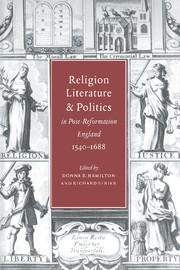Book contents
- Frontmatter
- Contents
- List of contributors
- Introduction
- 1 Sir John Oldcastle as symbol of Reformation historiography
- 2 The “sacred hunger of ambitious minds”: Spenser's savage religion
- 3 Subversive fathers and suffering subjects: Shakespeare and Christianity
- 4 Kneeling and the body politic
- 5 Donne and the politics of devotion
- 6 Catholic, Anglican or puritan? Edward Sackville, fourth Earl of Dorset, and the ambiguities of religion in early Stuart England
- 7 Crucifixion or apocalypse? Refiguring the Eikon Basilike
- 8 Marvell, sacrilege, and Protestant historiography: contextualizing “Upon Appleton House”
- 9 Entering The Temple: women, reading, and devotion in seventeenth-century England
- 10 Contextualizing Dryden's Absalom: William Lawrence, the laws of marriage, and the case for King Monmouth
- 11 Reformation in the Restoration Crisis, 1679–1682
- 12 Shadwell's dramatic trimming
- Index
8 - Marvell, sacrilege, and Protestant historiography: contextualizing “Upon Appleton House”
Published online by Cambridge University Press: 16 October 2009
- Frontmatter
- Contents
- List of contributors
- Introduction
- 1 Sir John Oldcastle as symbol of Reformation historiography
- 2 The “sacred hunger of ambitious minds”: Spenser's savage religion
- 3 Subversive fathers and suffering subjects: Shakespeare and Christianity
- 4 Kneeling and the body politic
- 5 Donne and the politics of devotion
- 6 Catholic, Anglican or puritan? Edward Sackville, fourth Earl of Dorset, and the ambiguities of religion in early Stuart England
- 7 Crucifixion or apocalypse? Refiguring the Eikon Basilike
- 8 Marvell, sacrilege, and Protestant historiography: contextualizing “Upon Appleton House”
- 9 Entering The Temple: women, reading, and devotion in seventeenth-century England
- 10 Contextualizing Dryden's Absalom: William Lawrence, the laws of marriage, and the case for King Monmouth
- 11 Reformation in the Restoration Crisis, 1679–1682
- 12 Shadwell's dramatic trimming
- Index
Summary
What should he do? He would respect
Religion, but not Right neglect:
For first Religion taught him Right,
And dazled not but clear'd his sight.
Sometimes resolv'd, his Sword he draws,
But reverenceth then the Laws.
(lines 225–30)While not referring directly to Lord Fairfax, the famous subject of Andrew Marvell's “Upon Appleton House,” these words from the poem's nunnery episode identify central issues involved in contemporary evaluations of Fairfax's career. In this episode, and by way of a fictionalized account of the dissolution of the nunnery, Marvell described the general's ancestor, William Fairfax, as a thoughtful, action-oriented hero about to gain possession of the Nun Appleton estate. Depicting him as worthy of emulation by future generations of Protestants, Marvell presented William's storming of the nunnery as both lawful and religiously motivated. Indeed, the contemplative moment that precedes his struggle with the nuns – “What should he do?” – dissipates as soon as the poem establishes that the proposed action is not unlawful: “The Court him grants the lawful form; / Which licens'd either Peace or Force, / To hinder the unjust Divorce” of his destined spouse from him (lines 234–6).
We can detect a playful defensiveness in these lines, as if Marvell were responding to an actual need to justify William's acquisition of church property.
- Type
- Chapter
- Information
- Publisher: Cambridge University PressPrint publication year: 1996
- 2
- Cited by



